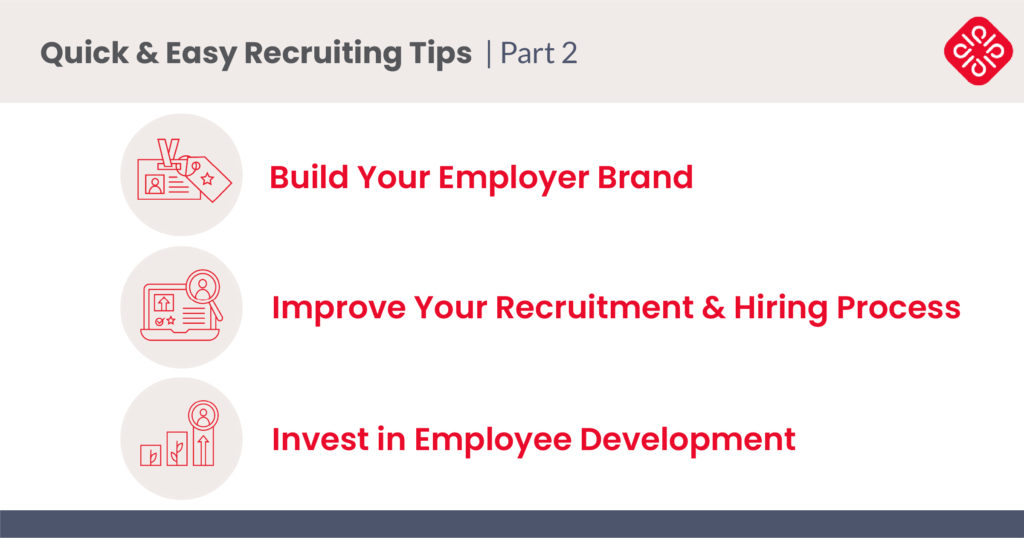In Part I, we covered three quick and easy recruiting tips that you can complete immediately to attract quality candidates. The three topics we covered included:
- Using inclusive language
- Selling the job
- Leveraging your network
This article (Part II) provides three long-term strategies you can implement over time. These methods will help you build a strong employer reputation leading highly-skilled candidates to seek your company out as an ideal place to work.

Build Your Employer Brand
This section includes four ideas to help organizations strategically build and promote the employer brand.
Tip 1: Build employer branding guidelines and a recruitment marketing strategy.
The easiest way to start this process is to ask the following questions about your organization:
- What are your core values?
- What is the company structure?
- How do you reward or recognize employees?
- What kind of career advancement is available?
- What kind of work/life balance do you offer?
Once the strategy and branding guidelines have been developed, incorporating the language everywhere, from offer letters and welcome emails to marketing materials, social media, and press releases.
Example: Sharing employee content and testimonials on your company website and social media profiles.
Tip 2: Ask for reviews.
High average ratings and reviews on sites like Glassdoor, Indeed, and Google help your employer brand stand out and attract quality candidates to your company. Quality job seekers are looking for your presence online. And whether or not a candidate chooses to apply, interview, or accept a job may be based on how other candidates and employees have rated and reviewed your company.
Example: Glassdoor is well-known for being an employer review site. No reviews? Your employer brand has no presence and may have a harder time attracting candidates. Building your employer brand on highly-trafficked online platforms, it enables job seekers to see what working at your company is really like for employees.
Tip 3: Nurture your talent pool.
There is nothing wrong with sending job alerts to potential candidates who have opted-in to hear from you. We recommend it! However, don’t just send job alerts. Passive candidates aren’t ready to apply. So instead, use your communications with them to nurture the relationship. At the moment, they may care more about company news or industry updates than job postings.
Example: Need ideas for what to include? Send content geared toward employee stories, diversity, equity & inclusion, or answer FAQs. You could also send helpful content to help them land the jobs you’re recruiting for.
Bonus tip: Nurture your prospects on social media too:
- Use images & videos for job descriptions/ads
- Employment-branded social media profiles & hashtags
- Share employee stories on social media platforms
Tip 4: Invest in college, trade school, and university partnerships.
Investing in relationships with colleges, trade schools, and universities is essential for a recruitment strategy. Over time, the relationships you build with these educational organizations will help you connect talented candidates looking for their first opportunity or utilize their alumni network to find new opportunities as seasoned professionals.
Example: Make a list of universities, technical schools, and community colleges in your area. Begin to post your jobs on their websites and set up a meeting with their employer-relations contact to jumpstart the conversation.

Improve Your Recruitment & Hiring Process
This section includes two simple tips that can make a world of difference when recruiting and hiring team members.
Tip 1: Treat candidates like customers.
To attract quality candidates over time, you should think of your candidates as your customers. You’ll be more likely to improve aspects of your employer brand by providing transparency, setting clear expectations, and consistently communicating with candidates. You should also work to accommodate candidates, impress them and provide a great hiring experience. This is true for candidates who don’t end up getting the job as well — their feedback about their experience with your company can have a deep and lasting impact on your employer reputation.
Example: Ask candidates for specifics about their experience in a brief “customer” survey. It can help you improve areas with blind spots and give candidates a controlled outlet in which to share feedback.
Tip 2: Simplify your hiring process and communicate with applicants.
As mentioned above, a candidate’s experience with your hiring process greatly influences your employer reputation. This is also true for applicants and the entire application process. We recommend making it as easy as possible to apply, let applicants know you’ve received their information, set clear expectations and provide updates on job openings.
Example: Use the “easy apply” button on platforms like LinkedIn or Indeed. Or, have an option to simply upload a resume with a subject line including the role in which they’re applying.

Invest in Employee Development
This section includes three ways you can invest in your employees, to show that you’re committed to their personal & professional development.
Tip 1: Invest in learning & development.
According to a LinkedIn Workplace Learning Report, 94% of employees say that they would stay at a company longer if there is an investment in their learning and development (L&D). By investing in L&D, you’re committing to your employees’ professional development, and it shows you’re invested in their futures. This contributes to engagement and retention among your current employees, and it can be a competitive advantage in your approach to recruiting. L&D is a win-win.
Example: L&D should be a part of your company values and culture. For example, AirBnB has a “Fireside Chats” program where outside experts talk to AirBnB employees.
Tip 2: Create a development plan.
According to ClearCompany, 74% of employees say that a lack of professional development prevents them from reaching their full potential. Creating an employee development plan allows each team member to see where they can go within the company and envision a future with clear goals and expectations.
Example: Take time to sit down with each team member to learn about their professional goals. Develop a plan for them to progress within the company.
Tip 3: Pair your employees with mentors within the company.
According to a recent CNBC/SurveyMonkey Workplace Happiness Survey, more than 9 in 10 workers (91%) who have a mentor are satisfied with their jobs, including more than half (57%) who are “very satisfied.” Mentorship programs can increase job satisfaction, resulting in better career outcomes for employees, and apply to all levels of seniority.
Example: Pair mentors and mentees according to mentees’ goals and mentor’s strengths within the company. Provide guided dialogue and discussion questions to help pairs maintain regular one-on-ones and build a rapport that isn’t possible in large group settings.
We hope the second part of this two-part series provided the information you’ve been seeking to support your recruiting goals! If you need additional resources to help attract qualified candidates, please don’t hesitate to reach out to us.
Read Part I: Attract Quality Candidates – Quick Recruiting Tips


